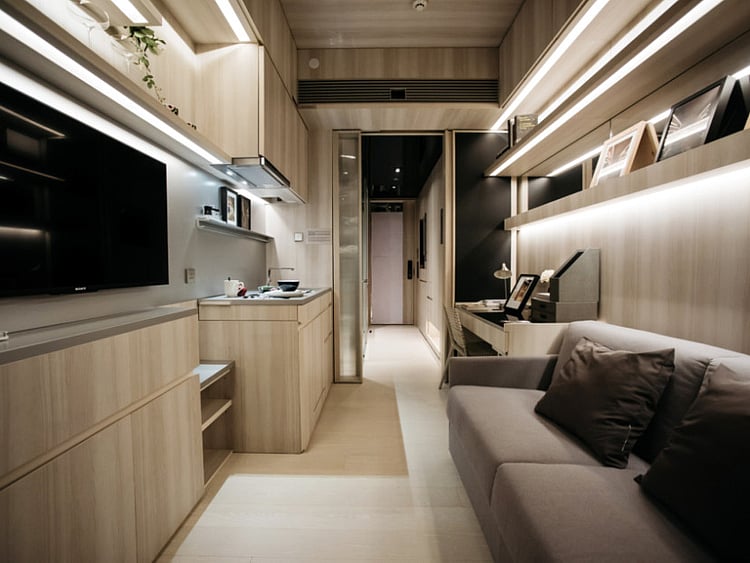Micro living: Would you live in a shoebox-sized apartment?
Lack of affordable housing, high living costs have made micro flats an attractive option

It’s just one room: the living room, bedroom and kitchen combined. And a partitioned bathroom. That’s micro living in a shoebox-sized apartment. While many may find it difficult to imagine, micro apartments are a reality across the world. Because city life is costly, and housing shortages make it worse.
Cities, no doubt, are magnets for humanity. Increased job opportunities, better pay and improved lifestyles are the lures that bring people from rural areas into cities. As a result, cities have become overpopulated.
When space is less and demand is high, skyrocketing rent makes city life unaffordable. That has led to the birth of micro apartments in expensive cities with dense populations.
Video: Micro living worldwide
Tiny homes, micro apartments or micro flats, and small living spaces have sprung up worldwide. They are called coffin homes, mosquito units, gnat flats, nano flats, shoebox homes, cage homes and cage beds, depending on the city. Typically ranging between 180 and 300 square feet, these tiny apartments are popular among the young and single, and even some retirees.
Due to their high cost of living, Tokyo, New York City, San Francisco, and Hong Kong are among the prime locations for micro apartments. In fact, micro living has thrived in most cities.
Here’s a look at micro apartments and why they are popular.
What is a micro apartment?
Micro apartments are tiny spaces that are a combination of a living room and bedroom, a kitchen and a bathroom. They are usually in the 100-500 square feet range and are smaller than studio apartments. The idea is to maximise living space per square foot without sacrificing amenities. Micro-apartments require less furniture and less utility usage.
What is the size of a micro apartment?
There are no official specifications. A typical micro apartment is usually less than 350 square feet. The Urban Land Institute in the US defines it as “a small studio apartment, typically less than 350 square feet, with a fully functioning and accessibility compliant kitchen and bathroom.” Single-room occupancies with communal kitchens and shared bathrooms do not qualify.
Do micro apartments have bedrooms?
Micro apartments follow an open concept, where the bedroom, living room, and kitchen are combined to save space. Many have innovative, efficient designs and flexible features. Dining room tables turn into beds, and shelves are placed on excess vertical spaces.
Why are they different?
Micro apartments are considered the urban equivalent of tiny houses. Living in a small space will require compromises and adjusting to a different lifestyle. It requires some modifications to ensure that the apartment contains all the amenities. That means tables and beds may be pulled out or folded away to make optimum use of the limited space.
The key is to practice minimalism. Fewer possessions, using multiple-purpose items and creatively using storage space will help.
Why choose a micro apartment?
Some choose micro apartments due to financial constraints, while environment–conscious city dwellers prefer to reduce their carbon footprints. Micro apartments use fewer resources and create less waste.
Why are micro apartments popular?
Micro apartments are common in places where housing is costly due to the shortage of dwellings. They are mostly found in big cities with booming populations.
They are popular since residents save on costs and can accommodate more housing in large cities. It’s favoured by many people, especially young professionals. Many seniors too have moved into micro apartments as they are an affordable, less high-maintenance option.
What are the benefits of living in micro apartments?
What’s the downside of living in micro apartments?
Are micro apartments sustainable?
Micro apartments require far fewer resources to build. A 2019 United Nations report estimated that reducing a home’s per-capita floor size could reduce the emissions from the building, besides trimming heating and cooling demand.
If micro living is popular, cities can invest in greener infrastructure like cycle lanes and improved public transportation.
How does it affect the environment?
Micro living increases population density, resulting in air pollution. It condenses greenhouse gas emissions to a smaller area, which can impact human health.
Studies show that population density creates an urban heat island effect. If there are not enough trees to reduce this effect of rising temperatures, demand for cooling goes up.
It affects plants and animals. Species loss occurs due to heat, and plants too will die in the absence of pollinators. So green spaces are vital in communities that encourage micro living.
Which cities are popular for micro flats?
Micro flats have been the trend for several decades. Tokyo, Hong Kong, Manhattan, London and Paris are some of the thousands of cities with tiny apartments. You can even find them in Pasay (the Philippines), Austria, Indonesia and Taiwan.
Here’s a look at three countries.
United States: In Seattle, they’re called SEDUs — small efficiency dwelling units. In Boston, they are known as innovation units. In Chicago, they are termed Flats. New York City opened the doors of its first prefab micro apartment building in 2015. Los Angeles and San Francisco have followed suit.
Japan: The country could well be the home of micro living. According to reports, some architects claim that kyosho jutaku (Japanese micro home) has been popular since the thirteenth century. But the popularity of micro-apartments soared in the 1990s. People in their 20s and 30s, who make up about 90 per cent of the tenants
China: With more and more migrant workers moving to the bigger cities, it’s increasingly difficult for workers to find affordable living spaces, especially in Hong Kong, Guangzhou and Shanghai. According to an international survey, Hong Kong has the most unaffordable housing in the world. Micro flats have helped resolve the housing crisis in these cities.
Sign up for the Daily Briefing
Get the latest news and updates straight to your inbox
Network Links
GN StoreDownload our app
© Al Nisr Publishing LLC 2025. All rights reserved.